Results 151 to 180 of 310
-
2023-10-30, 02:54 PM (ISO 8601)Ettin in the Playground

- Join Date
- Nov 2010
- Location
- Toledo, Ohio
- Gender

 Re: Got a Real-World Weapon, Armour or Tactics Question? Mk. XXX
Re: Got a Real-World Weapon, Armour or Tactics Question? Mk. XXX
The common picture of WWI generals in general and Haig in particular as idiot butchers is outdated. They were constantly trying to find ways to break the stalemate, most of which looked really good on paper but wound up having unforeseen drawbacks. The incredible casualty rates were a function of the unprecedented scale of the conflict (nobody had ever thrown anywhere near as many men into a fight) and the breakneck advancement of killing technology since the last major war. They "got away with it" because the alternative was outright defeat - which risked consequences far worse than mere casualties.
-
2023-10-30, 08:59 PM (ISO 8601)Ettin in the Playground

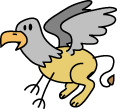
- Join Date
- Jun 2013
- Location
- Bristol, UK
-
2023-10-30, 10:22 PM (ISO 8601)Ogre in the Playground

- Join Date
- Sep 2008
 Re: Got a Real-World Weapon, Armour or Tactics Question? Mk. XXX
Re: Got a Real-World Weapon, Armour or Tactics Question? Mk. XXX
I guess that depends a bit on the definition of permanent? I'm not sure how common it was to use unfaced earth in what was expected to be a permanent work (or in a work that was actually permanent).
I just checked the section on the Dutch Revolt in Christopher Duffy's Siege Warfare: The Fortress in the Early Modern World, 1494Â1660, and he mentions that the Dutch were fond of making huge complicated earthwork fortifications. Cheap and easy to throw up, the problem was that they immediately began deteriorating. Even a few months after construction major fortresses needed significant manpower to repair them. Many (if not most) no longer exist for this reason. They were either replaced by brick/masonry, or simply left to "melt" into the landscape.
Making the wall (aka rampart) of earth with a masonry shell was a standard practice for a permanent "trace italienne" (I think even the old, tall medieval walls were filled with rubble?). But the masonry fortresses were expensive. Another option was to use earth to fortify an existing (old fashioned) city wall. Either by working the wall directly into the earthwork, or by placing an earthwork farther out (or some combination). These were temporary by nature, and in some cases helped preserve the old medieval walls. You can see an example of this in the painting of the siege of Florence 1529-30:
https://en.wikipedia.org/wiki/Siege_...ce_(15291530)Last edited by fusilier; 2023-10-30 at 10:24 PM.
-
2023-10-30, 11:28 PM (ISO 8601)Ogre in the Playground

- Join Date
- Aug 2022
 Re: Got a Real-World Weapon, Armour or Tactics Question? Mk. XXX
Re: Got a Real-World Weapon, Armour or Tactics Question? Mk. XXX
It was honestly worse than that IMO. WW1 was basically this absurdly perfect combination of specific technologies developing "just enough" to weigh things in particular ways that lead to stalemate, but "not enough" to end it. Air power was "just enough" advanced to allow a high degree of battlefield knowledge, but "not enough" to be used effectively on offense. This meant that both sides could see exactly where the other side was massing troops, well in advance of those troops actually getting where they were going. Telecommunications had developed "just enough" to send effective and fast communications (like say from the airdomes where the planes returned from scouting the front), but "not enough" to allow fully mobilized communication. This meant that you could react and block enemy movements very effectively as long as you were chained to a telegraph line or other source of communication. Units off "on their own" could be spotted and destroyed easily, so everyone just formed up into longer and longer lines of battle with neither side being able to "break though". And yeah, ground weaponry had advanced "just enough" to be ridiculously powerful when fixed in position, but "not enough" to be mobile (whether we're talking about machine guns, tanks (more or less a non-factor at this point), or artillery). Every single thing in that period leaned things heavily in the "guy standing his ground wins" direction.
Fast forward a couple decades and every one of those technologies developed further, creating (arguably requireing) a far more mobile use of military forces. So yeah, it's easy to look at the horrible decisions made in some of the WW1 battles, with the benefit of hindsight. But at the time, they didn't know just how futile some of these attempts would actually be. So you really can't blame them for trying. And yeah, I suppose there's also that truism that wars are fought with today's weapons, but using the tactics and assumptions developed in the last war. They were at least trying new things. Just didn't always work well.
-
2023-10-31, 12:14 AM (ISO 8601)Troll in the Playground

- Join Date
- Jul 2015
 Re: Got a Real-World Weapon, Armour or Tactics Question? Mk. XXX
Re: Got a Real-World Weapon, Armour or Tactics Question? Mk. XXX
Forces also just became more mobile in and of themselves. WWI land transport relied on railroads, which follow fixed routes that have to be laid in advance. WWII land transport utilized trucks and tracked vehicles which had much greater flexibility to either use extensive road networks or just off-road to wherever they wished. Airborne deployment and supply also became a functional option by the end of the war, at least for forces that had air superiority.
-
2023-10-31, 12:42 PM (ISO 8601)Ogre in the Playground


- Join Date
- Aug 2013
 Re: Got a Real-World Weapon, Armour or Tactics Question? Mk. XXX
Re: Got a Real-World Weapon, Armour or Tactics Question? Mk. XXX
That was certainly done in some cases. It all depended on the materials available locally and how much time and money you were investing in the wall.
The Chinese built a lot of walls this way too. E.g. the oldest parts of what isn't actually just one wall system in the Great Wall of China was tamped down earth with various shrubbery (am sure nice ones) throw in to help bind it. Some of these out in the Taklamakan desert (or something like that, my memory on where isn't exactly pristine) still exists.
-
2023-11-01, 02:11 PM (ISO 8601)Firbolg in the Playground


- Join Date
- Nov 2009
- Gender

 Re: Got a Real-World Weapon, Armour or Tactics Question? Mk. XXX
Re: Got a Real-World Weapon, Armour or Tactics Question? Mk. XXX
I have seen the same question asked about a kind of Classical Greek shield, somewhat similar to the Mycenean figure-of-eight shield often seen on vases. The purpose of the empty spaces is far from clear there, too. Some have thought it could be to let the spear through, but it's far from certain. Some even tried to explain their presence in images as a more "heroic" defensive weapon that the round shield, but that also doesn't really hold when compared to evidence.
About the pelta, I have found some images of pelta-equipped Amazons on vases. (Photos not by me) What I find interesting is that the middle of the inner arc seems to develop in an outward spike. It's not very noticeable and even doubtful here, but it's very clear here. Amazons are generally depicted in Skythian clothing, which is why they often wear decorated, very tight pants. Skythian warriors are generally depicted wearing similar clothes, a bow, a quiver hung at the waist, a sagaris, and a crescent-shaped pelta.
Both Skythians and Amazons were considered horse-riding nomads, with a famous description of a Persian emperor trying to subjugate the Skythians, only for them to avoid him by moving farther and farther away in their endless plains, until he had to go back.
Now, this is just my hypothesis, but I suspect that the moon-shaped pelta having something to do with reins might be the right answer. I didn't look up where it was produced, but Greeks occasionally adopting the shield because they bought it somewhere north or because they simply reproduced the construction technique seems possible. And there were a lot of foreigners moving around the Greek world, with the Ionian cities facing the Persians and the Cimmerians.
This brings me back to the eight-shaped-shield. As it turns out, the Persians, originally a nomadic people of horse-riders, also used them. Maybe they simply were built the same way as the peltas, maybe they were a consideration for using reins, but I wouldn't be surprised if the Greeks imported them from the East. There was a whole era called the Orientalising Period about Eastern cultural motifs making their way into Greek art, and I wouldn't be surprised if some weapon models had also been imported. Originally Posted by J.R.R. Tolkien, 1955
Originally Posted by J.R.R. Tolkien, 1955
-
2023-11-02, 01:04 AM (ISO 8601)Troll in the Playground


- Join Date
- Oct 2014
- Location
- Tulips Cheese & Rock&Roll
- Gender

 Re: Got a Real-World Weapon, Armour or Tactics Question? Mk. XXX
Re: Got a Real-World Weapon, Armour or Tactics Question? Mk. XXX
I was going to give loads of examples, but I figure we're actually in agreement here. Parts of these forts are often masonry. Can be a steep outer wall, a dam to keep the moat wet, barracks inside the earth walls, but most of the cannon ball stopping power is still provided by the tons of dirt. I counted that as permanent earthworks. Although it may or may not be the right term.
I mean, not a historian, but just looking at these things they're pretty green.
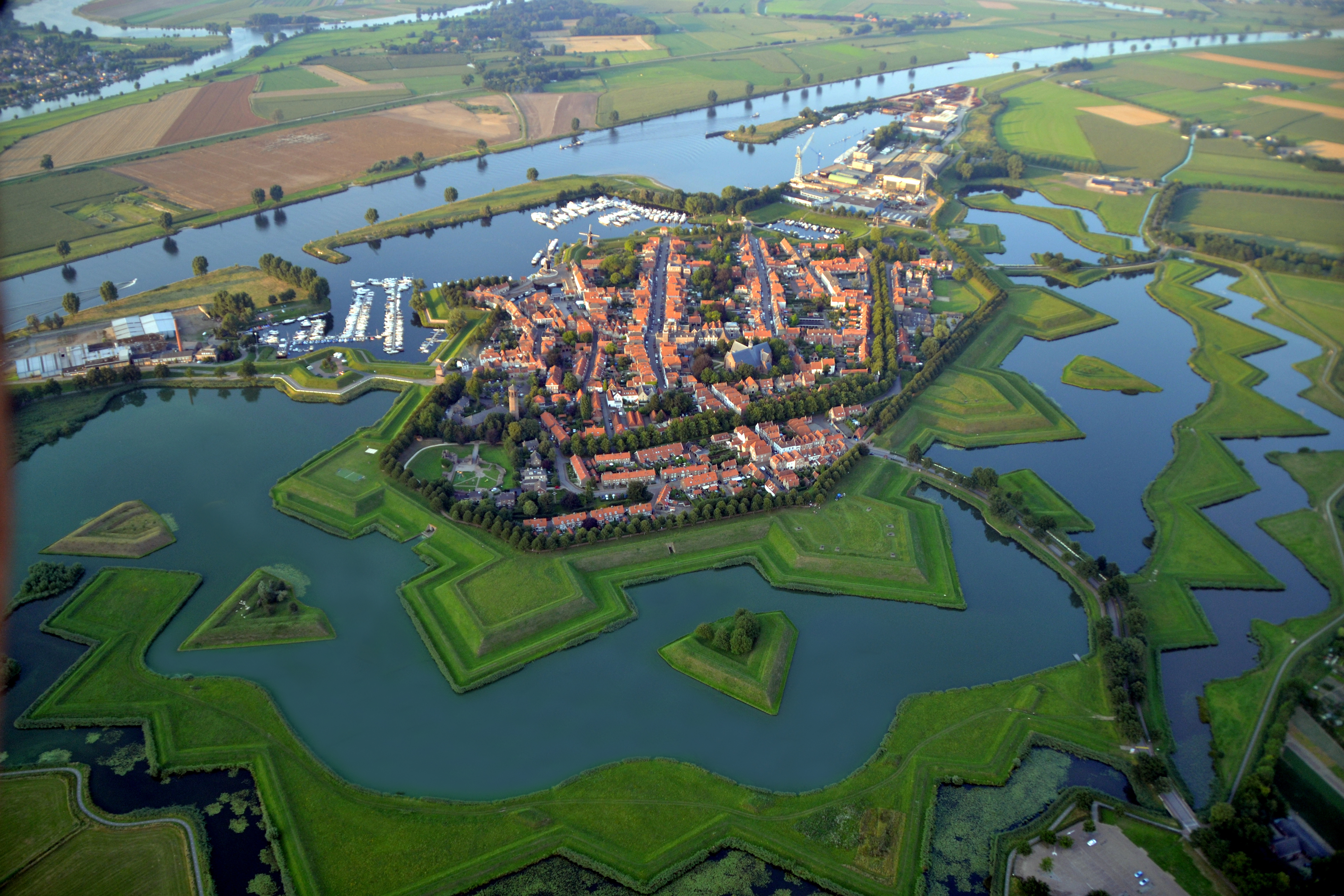 The Hindsight Awards, results: See the best movies of 1999!
The Hindsight Awards, results: See the best movies of 1999!
-
2023-11-02, 06:15 PM (ISO 8601)Ogre in the Playground

- Join Date
- Sep 2008
 Re: Got a Real-World Weapon, Armour or Tactics Question? Mk. XXX
Re: Got a Real-World Weapon, Armour or Tactics Question? Mk. XXX
Yeah, there may very well be more of these than I realized, I fully admit that. As I mentioned if you can get sod to take on them, that will do a lot to reduce erosion, and maybe many were retained as permanent that way. It looks like it's being well maintained as a park now.
As you say it's the earth that gives most of the resistance. Typically masonry versions of these forts have earth in between the walls, but all the surfaces are faced in stone or brick (which might make them look like they're solid stone, but they're not). Initial cost is a lot greater but maintenance is much lower (erosion is much less of a factor). Some seacoast fortresses may have been made out of solid stone or brick (like Fort Sumter perhaps) but with a different plan.
-
2023-11-02, 09:27 PM (ISO 8601)Ogre in the Playground

- Join Date
- Sep 2008
 Re: Got a Real-World Weapon, Armour or Tactics Question? Mk. XXX
Re: Got a Real-World Weapon, Armour or Tactics Question? Mk. XXX
By the way, the image is of Heusden. The earthwork was built in 1613, but by the early 19th century had fallen into disrepair and had been dismantled. It was "restored" (carefully rebuilt) beginning in 1968. Some of the walls in this photo from 1960 still look in decent shape (others appear to be gone completely), although nothing as pleasant as today. Most of the outworks are missing and the moat looks like it could use cleaning. I wonder if the old walls were maintained to serve as a kind of levy?

From here:
http://hvdol.nl/database/product_inf...657dd0a512e869
While the caption says it's before the restoration, I notice that one of the bastions has earth piled up in it. Maybe restoration work of some sort had already started?
-
2023-11-03, 12:10 AM (ISO 8601)Ogre in the Playground


- Join Date
- May 2018
 Re: Got a Real-World Weapon, Armour or Tactics Question? Mk. XXX
Re: Got a Real-World Weapon, Armour or Tactics Question? Mk. XXX
Parts of that 1960s pre-restoration photo look pretty decent for being 350 years old. Im not sure whats going on with the moat. Either its been silted in quite badly, or its in the process of being drained in preparation for some work.
My Perpetually-Unfinished Homebrew: Tier-3 Class Suite, Homestuck Races for Pathfinder, Homestuck Races for 5e, Psionic Class Redux
-
2023-11-03, 02:28 PM (ISO 8601)Ogre in the Playground

- Join Date
- Sep 2008
 Re: Got a Real-World Weapon, Armour or Tactics Question? Mk. XXX
Re: Got a Real-World Weapon, Armour or Tactics Question? Mk. XXX
Just to be clear, there must have been some maintenance and upkeep done. I can't believe that those walls were made in 1613, then just left to weather! But even if upkeep had been stopped in the early 1800s, they look pretty good, which made me wonder if some of them were being maintained for some other reason.
-
2023-11-04, 04:55 AM (ISO 8601)Troll in the Playground


- Join Date
- Oct 2014
- Location
- Tulips Cheese & Rock&Roll
- Gender

 Re: Got a Real-World Weapon, Armour or Tactics Question? Mk. XXX
Re: Got a Real-World Weapon, Armour or Tactics Question? Mk. XXX
I'll admit that I picked this image pretty randomly, or, well, I googled a bit to find a nice green looking example. From what I can find Heusden was still actively being used in warfare at least around 1800, the Napoleonic era.
It was part of the southern waterline. Elements of the western part of this line stayed in official use until 1953, google tells me, as a continuation of the new Holland waterline and part of "fort Holland", and some parts were even still upgraded around 1930. I don't know if Heusden was one of these elements, but it does sit around the most eastern point of this western section.

The only thing I can find about its WW2 history is that retreating Germans eventually blew up the highest buildings to prevent them from being used as watchposts, but that wouldn't really have been a thing because of any fortifications. You can blow up a church tower anywhere for that reason. So... anywhere between 160 and 7 years of disrepair on that 1960 photo. Probably not 7.
Note about that image: it shows inundations, places that were flooded during wartime as giant muddy moats. But this many would never have been flooded at the same time. It for instance shows both the old and new Holland waterline, passing west and east of Utrecht (the city, not the province) respectively. The new one was a very deliberate replacement of the old one, a reaction to longer ranging artillery, they would not have been flooded together.
(Fun fact: the only tank the Netherlands procured before WW2 was one of the WW1 model Renault FT tanks. (Awesome design for its time, but very underpowered in every way by WW2 standards.) They bought it for training purposes, ending up driving it into some part of a waterline and concluding "it's very stuck in the mud now, we're safe". While that conclusion may not in fact have been too far off reality, a giant open plane of water and mud is not ideal tank territory, I still feel the limited scope of testing here shows an underestimation of the tank as a weapon system.)
Editorial note: this is a phone post. I already found and corrected several horribly mangled words, but there are bound to be more.Last edited by Lvl 2 Expert; 2023-11-05 at 05:35 AM.
-
2023-11-06, 04:47 AM (ISO 8601)Barbarian in the Playground


- Join Date
- Dec 2010
- Location
- Germany
- Gender

 Re: Got a Real-World Weapon, Armour or Tactics Question? Mk. XXX
Re: Got a Real-World Weapon, Armour or Tactics Question? Mk. XXX
Please note that I try to avoid historical examples, so this isn't tied to any specific era, nation or conflict. I also try to answer from the perspective of wartime decision-makers and warring societies as a whole, rather than from an individualistic, humanitarian point of view.
Even if mass killings, displacement, torture, enslavement or the loss of indispensable human and civil rights are not to be expected after a surrender, complete military defeat (let alone occupation by a foreign power) equals near-total loss of control. This has a sudden and unpredictable impact on the political, military, legal and economic (and sometimes cultural and religious) order of a society. Such impacts can be more drastic and more permanent than even great loss of resources and human life, so these are sacrificed in an attempt to prevent the feared collapse of social norms and values as well as the loss of collective and individual identities.
-
2023-11-06, 06:59 AM (ISO 8601)Firbolg in the Playground

- Join Date
- Nov 2012
- Gender

 Re: Got a Real-World Weapon, Armour or Tactics Question? Mk. XXX
Re: Got a Real-World Weapon, Armour or Tactics Question? Mk. XXX
To know that, look at what happened to the losers of the war. You can see a pretty big impact on those societies. And that was with their enemies also exhausted. A more complete defeat would have seen them push harder. It's also important to know that generals and politicians are people and because of that, they look at their own positions. And no one is going to survive a major defeat like that. Definitely not in their positions and there even is a good chance of outright death and loss of wealth and property that would otherwise have gone to their children.
Make Egypt Great Again: Waking up as Cleopatra VII Philopator My ongoing attempt at writing a story.
My Homebrew for 3.5
-
2023-11-06, 07:45 AM (ISO 8601)Troll in the Playground


- Join Date
- Oct 2014
- Location
- Tulips Cheese & Rock&Roll
- Gender

 Re: Got a Real-World Weapon, Armour or Tactics Question? Mk. XXX
Re: Got a Real-World Weapon, Armour or Tactics Question? Mk. XXX
One thing I only just noticed about Heusden, after remembering looking up some stuff (on the Dutch Wikipedia) I remembered having heard of: it is very much an "oud-Nederlands vestingstelsel" design. Around 1685 there was a rethink of how these fortifications should be done. In this new style you often see large bastions with an arrow shape, built-in firing slits/grooves/casemates for the cannons and often a steep stone finish as the outer wall. (So yes, I picked an old style example accidentally on purpose.) But the biggest difference might be the advice to limit the elements outside of the moat, typically having only a single "glacis" outside of the moat. These guidelines were never applied consistently across projects, every head engineer, mayor or officer probably had their own ideas, and you're still working with the local terrain. But I would still hazard a guess that Heusden hasn't seen a major refit after 1700. So while functional it wouldn't have been the flagship of the fortifications fleet around 1800.



It's not a foolproof method of identifying fortifications, Naarden for instance has been updated and is today seen as the best surviving example of the new system, but it still has a bunch of stuff in front of the main moat.
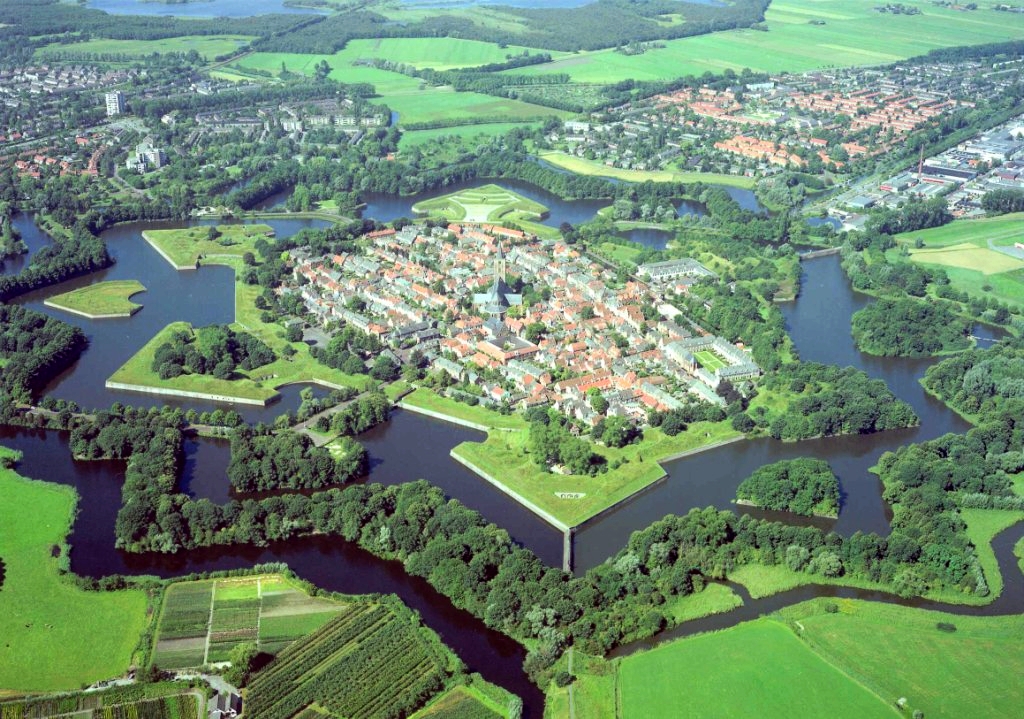
In later years more smaller forts were build rather than/in addition to these "vestingen", as part of (water) lines or as the defenses for cities too large to wall into a nice single vesting. Fort Ruigenhoek wasn't build until 1870. It still includes the earthen bullet stopper walls, although more stone is clearly visible here too.

Last edited by Lvl 2 Expert; 2023-11-07 at 11:14 AM.
-
2023-11-06, 04:55 PM (ISO 8601)Barbarian in the Playground

- Join Date
- Feb 2010
- Location
- Slovakia
- Gender

 Re: Got a Real-World Weapon, Armour or Tactics Question? Mk. XXX
Re: Got a Real-World Weapon, Armour or Tactics Question? Mk. XXX
High and late medieval, you see a massive amount. The chivalric culture liked to hold up the people who did these things quite high up, and so did Islam. Ibn Battuta and Villani have very different chronicles, but one thing they have in common is praising courage in face of overwhelming odds, even if both of the authors aren't exactly keen to be the heroes in that regard.
These tend to be at a fairly low level, at most a wing of about a thousand strong attacking and being wiped out by a much stronger force, often when trying to break out of a bad position. You only rarely see kings and dukes do these but it does happen, the Crecy and the last charge of Czech king John the Blind (who was, well, blind at the time) comes to mind.
Universally applied over the entire continent, pretty much. You just need to think smaller: since we got rid of the oppidums of early medieval era, larger settlements and castles were made of stone or brick, but they were only a small portion of total fortified structures. Since about 1200s to early modern period, you get frequent mentions of woodwork or earthwork forts, from just a row of tree trunks serving as a pallisade to a village to wooden towers on small hills serving as lookouts.
Spoiler: High medieval house of a rural knight
Not sure about the varacity of this one, it looks about right when I compare it to the textual stuff I have, but the photo is... poorly described to say the least
Still, it does look right
Spoiler: High medieval Hungary reconstruction, note wall in back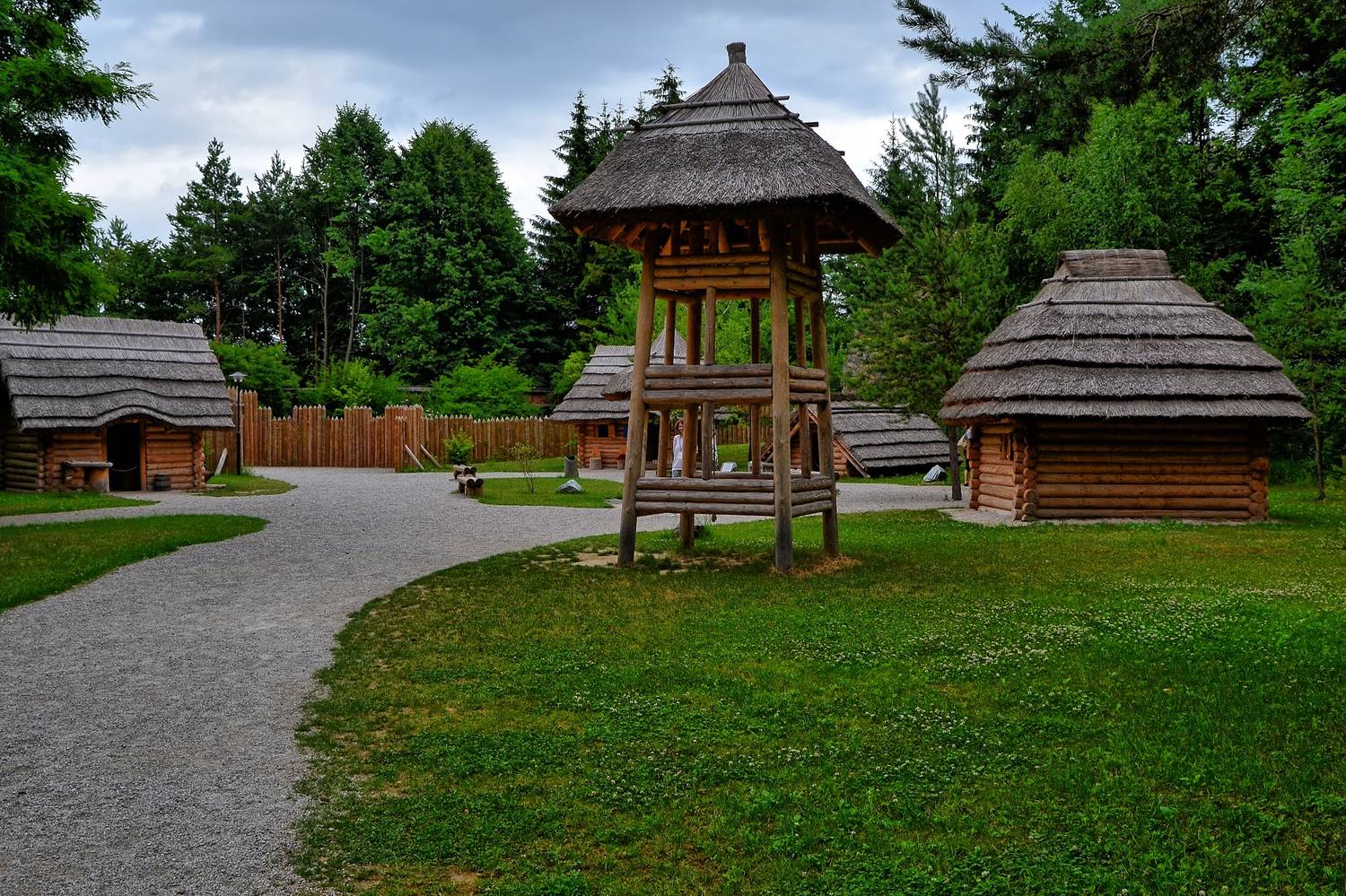
Spoiler: Ottoman era watch tower, this one is made of stone, documents mention purely wooden ones
From textual sources, Carmen Miserabile describes Mongol invasion of Hungary and how every single one of the many settlements on Hungarian plain, protected by earthworks and only sometimes moats were exterminated. Villani's chronicles of Florence also frequently mention wood and earthworks being used to fortify mountain passes (sometimes permanently, or at least over several years), villages or temporary military camps. A whole slew of documents relating to municipal expenses of larger cities mention rebuilding their earthworks into proper stone walls.
And finally, many stone fortifications had one more ring made of wood or earthworks that was destroyed.
Spoiler: Beckov castle, reconstruction of outermost pallisade wall visible bottom right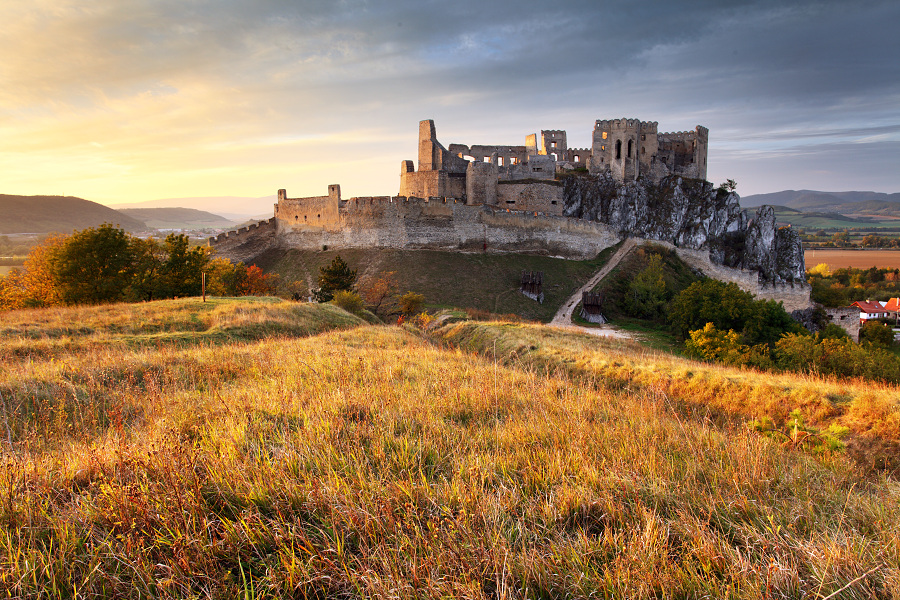
You tend not to see a lot of them because they were destroyed or decayed, and you don't hear about them in major chronicles because they aren't very exciting. You need to go fairly close to the ground, to accounts by people actually there, e.g. Villani and Rogerius, or to financial reports to hear about them.That which does not kill you made a tactical error.
-
2023-11-06, 07:06 PM (ISO 8601)Ogre in the Playground

- Join Date
- Oct 2013
 Re: Got a Real-World Weapon, Armour or Tactics Question? Mk. XXX
Re: Got a Real-World Weapon, Armour or Tactics Question? Mk. XXX
British WW1 casualties were not notably worse than anyone else, it's just that a generation of young people wrote about their experiences in English, so they're most well known.
-
2023-11-06, 11:11 PM (ISO 8601)Ettin in the Playground


- Join Date
- Jun 2013
- Location
- Bristol, UK
 Re: Got a Real-World Weapon, Armour or Tactics Question? Mk. XXX
Re: Got a Real-World Weapon, Armour or Tactics Question? Mk. XXX
Absolutely right, the losses overall were horrendous almost all around. "All quiet on the Western front" is a quote of a German headline on a particular, possibly fictitious but representative day, when 37,000 germans died on that front. Soldiers died all over of their commander's stupidity in that war.
 The end of what Son? The story? There is no end. There's just the point where the storytellers stop talking.
The end of what Son? The story? There is no end. There's just the point where the storytellers stop talking.
-
2023-11-06, 11:33 PM (ISO 8601)Troll in the Playground

- Join Date
- Jul 2015
 Re: Got a Real-World Weapon, Armour or Tactics Question? Mk. XXX
Re: Got a Real-World Weapon, Armour or Tactics Question? Mk. XXX
That number is certainly fictitious. Germany was engaged in WWI for ~1500 days and suffered ~2,000,000 total deaths (twice that wounded). The average German daily death toll was ~1350. While this obviously did not occur evenly, any day that saw 37,000 deaths would represent a massive battle with hideous losses. For comparison, German casualties (killed and wounded) for July 1-10, 1916 - the initial ten days of the Somme - were only 46,319.
-
2023-11-07, 12:17 AM (ISO 8601)Ogre in the Playground

- Join Date
- Sep 2008
 Re: Got a Real-World Weapon, Armour or Tactics Question? Mk. XXX
Re: Got a Real-World Weapon, Armour or Tactics Question? Mk. XXX
That's called a "retired flank" (or "orillon"). Cannons mounted on the flanks of the bastion are critical for sweeping the moats, and therefore any assault against the walls. A besieger would usually target those cannons with their own artillery, to destroy them before any attack. The retired flank helped protect those cannons in the flank from enemy batteries. Retired flanks had been developed in the early 16th century (Forte Sangallo, built 1501-03, well before 1685*, may be the first?) -- but something has to be understood about the trace italienne system of fortification . . .
It consists of a large collection of features that interact with each other with a mathematical foundation: nobody used all of the features at the same time!! There's a fundamental structure the basic shape of the walls and bastions (aka their "trace", which results in what is nowadays often referred to as a "star fort" (but historically this was something different).
Outside of those basics, there quickly developed a bewildering array of outworks and modifications/variations. There are retired flanks, and even double retired flanks. Ravelins could be augmented by lunettes, and/or bonettes, or tanaillons; ravelins could be flanked or unflanked; a redoubt could be put into a ravelin; and that's not getting into the crownworks, hornworks, etc. (or should I say ad nauseam!) But there was still a mathematical design to how they worked and interacted with the main fortress walls.
The engineer had plenty of options to choose from, and may be influenced by local conditions, adding extra pieces to reinforce a particular vulnerable or important location. Or to allow the work to extend to cover some other important place that could not fit in the neat geometry of the basic design, which was, ideally, a regular polygon. (or would require a prohibitively large main work).
Retired flanks seem more common on masonry/brick works, than the pure earthwork style. And by the 19th century you can find plenty of works lacking them. The design of such forts in the American Civil War era, for example, generally just seem to follow the basics.
It's been a while since I've studied such fortresses and I'm sure there are details I've forgotten, but I did go through the exercise of the geometry of laying out a trace of a couple of different "bastioned forts", as they were called, on paper.
The aforementioned Siege Warfare, by Christopher Duffy, covers the development of the "trace italienne" in good detail.
Fortress, by Ian V. Hogg, is more of a general historical overview, but has an entire chapter dedicated to the "Drawing Board Approach", which explains this style very well.
Both works are a bit dated, but probably serve well for introductions, especially to the general development and approach of fortress construction.
*The date, 1685, makes me think it could be a reference to Vauban. Vauban's works on fortresses really just provide a synthesis of ideas that had been developed long before, but his systematic approach may have encouraged new works to use variants that had been overlooked in earlier fortifications. Although on further investigation, the illustration refers to Coehorn's second method, who seemed to have adopted a particularly deeply retired flank.
-
2023-11-07, 01:37 AM (ISO 8601)Ettin in the Playground


- Join Date
- Jun 2013
- Location
- Bristol, UK
 Re: Got a Real-World Weapon, Armour or Tactics Question? Mk. XXX
Re: Got a Real-World Weapon, Armour or Tactics Question? Mk. XXX
The German was apparently "Im Westen nichts Neues" it was a book, and that's all of it that I remember.
https://en.wikipedia.org/wiki/All_Qu..._Western_Front
It was supposed to be late in the war, and maybe retreats weren't headlined, but anyway, it was a non-english anti-war book. The end of what Son? The story? There is no end. There's just the point where the storytellers stop talking.
The end of what Son? The story? There is no end. There's just the point where the storytellers stop talking.
-
2023-11-07, 05:42 PM (ISO 8601)Ogre in the Playground

- Join Date
- Oct 2013
 Re: Got a Real-World Weapon, Armour or Tactics Question? Mk. XXX
Re: Got a Real-World Weapon, Armour or Tactics Question? Mk. XXX
Most likely that was casualties, which include dead, wounded, prisoners and missing. Casualty information is hard to collect, , reliable figures are never that precise.
There were alot of WW1 casualties, but that doesn't mean the commanders were necessarily awful, it's just that what they were trying to do was hard. There's kind of a meme that assumes the COs were General Melchett, but the truth is far more complicated.
-
2023-11-08, 05:17 AM (ISO 8601)Ettin in the Playground


- Join Date
- Jun 2013
- Location
- Bristol, UK
 Re: Got a Real-World Weapon, Armour or Tactics Question? Mk. XXX
Re: Got a Real-World Weapon, Armour or Tactics Question? Mk. XXX
Haig was a cavalry man, and wanted a breakthrough that cavalry could exploit. With opposition of machine guns and artillery that wasn't going to happen.
Attrition was a policy of military despair, which meant throwing away allied lives, in the hope that they'd take enough lives from the Germans and their allies (what was the name for that side as a whole?) that the bigger population would win. That was stupid, and the politicians backed it, but how they thought that was right I can't imagine. Britain was not at serious risk of invasion at any point in WW1. The end of what Son? The story? There is no end. There's just the point where the storytellers stop talking.
The end of what Son? The story? There is no end. There's just the point where the storytellers stop talking.
-
2023-11-08, 05:36 AM (ISO 8601)Ogre in the Playground


- Join Date
- May 2018
 Re: Got a Real-World Weapon, Armour or Tactics Question? Mk. XXX
My Perpetually-Unfinished Homebrew: Tier-3 Class Suite, Homestuck Races for Pathfinder, Homestuck Races for 5e, Psionic Class Redux
Re: Got a Real-World Weapon, Armour or Tactics Question? Mk. XXX
My Perpetually-Unfinished Homebrew: Tier-3 Class Suite, Homestuck Races for Pathfinder, Homestuck Races for 5e, Psionic Class Redux
-
2023-11-08, 06:10 AM (ISO 8601)Troll in the Playground


- Join Date
- Oct 2014
- Location
- Tulips Cheese & Rock&Roll
- Gender

 Re: Got a Real-World Weapon, Armour or Tactics Question? Mk. XXX
Re: Got a Real-World Weapon, Armour or Tactics Question? Mk. XXX
8 sided star? Add some indentations between the points to make them look more like bastions. The ravelins in front of the indentations will look pretty funky though. If you're happy with just four points the ravelins will probably look a bit better,
Honestly I feel like the general design works best with 6 points though, so 45 degree angles is just kind of tough.
(I'll try a little sketch when I'm home later.)The Hindsight Awards, results: See the best movies of 1999!
-
2023-11-08, 06:16 AM (ISO 8601)Orc in the Playground

- Join Date
- Jul 2019
 Re: Got a Real-World Weapon, Armour or Tactics Question? Mk. XXX
Re: Got a Real-World Weapon, Armour or Tactics Question? Mk. XXX
Here's a blog series on why the WWI trench stalemate was so awful.
https://acoup.blog/2021/09/17/collec...nch-stalemate/
-
2023-11-08, 06:48 AM (ISO 8601)Troll in the Playground

- Join Date
- Jul 2012
- Gender

 Re: Got a Real-World Weapon, Armour or Tactics Question? Mk. XXX
Re: Got a Real-World Weapon, Armour or Tactics Question? Mk. XXX
Britain/France/Russia were the Triple Entente in WWI. Germany/Austria-Hungary were the Triple Alliance.
The names originate from the Entente Cordiale between Britain and France, the Franco-Russian Alliance, and the Anglo-Russian Entente, which put the centuries old rivalry between the three countries to bed and created an informal political bloc opposed to central European powers.
Germany, Italy and Austria-Hungary had a defensive alliance, making them formal allies. Italy skipped out on the war at first because they didn't consider it a defensive war, later joining the Entente powers, but the name Triple Alliance stuck.
While the Entente powers did wind up referring to their group as the Allies during and after the war, I don't think a name was ever attributed to the Triple Alliance in English, so it's better for clarity to refer to the 'the Allies' as 'the Entente' imo.Last edited by Grim Portent; 2023-11-08 at 06:51 AM.
Sanity is nice to visit, but I wouldn't want to live there.
-
2023-11-08, 07:30 AM (ISO 8601)Troll in the Playground


- Join Date
- Oct 2014
- Location
- Tulips Cheese & Rock&Roll
- Gender

 Re: Got a Real-World Weapon, Armour or Tactics Question? Mk. XXX
Re: Got a Real-World Weapon, Armour or Tactics Question? Mk. XXX

What I meant. On the 8 pointed star you're either working with very thin or very wide ravelins. The very thin ones look better, but not a lot of space there. On the four pointed star the firing lines look off, the stars need to be able to jut out more, maybe another 22.5 degree step in between, to make it work well. The ravelins are also maybe a little fat.
On the six sided design the ravelins look just about right, although you need to use lines in 12 directions rather than just six to add those nice pointy points that really make the firing lines work. Without it you've just got weird flat caps for bastions. So basically the same problem we saw on the 4 sided star, where you'd want to use 16 directions instead of 8.
The four sided version might work if you leave out the ravelins alltogether and make the flat sides of the bastions long enough, and keep the overall fort kind of small. Those sides cover the adjacent points kind of decently...Last edited by Lvl 2 Expert; 2023-11-08 at 07:36 AM.
The Hindsight Awards, results: See the best movies of 1999!
-
2023-11-08, 07:35 AM (ISO 8601)Ogre in the Playground


- Join Date
- May 2018
 Re: Got a Real-World Weapon, Armour or Tactics Question? Mk. XXX
Re: Got a Real-World Weapon, Armour or Tactics Question? Mk. XXX
Yes, an 8-pointed design seems the easiest starting point. But that still leaves so many design decisions up in the air. For reference, here are some of the ideas I was toying around with.
Edit: Didn't see your most recent post. That's interesting. It looks like we started with our bastions at different locations. Rotated 12.5° from each other.Last edited by Maat Mons; 2023-11-08 at 07:42 AM.
My Perpetually-Unfinished Homebrew: Tier-3 Class Suite, Homestuck Races for Pathfinder, Homestuck Races for 5e, Psionic Class Redux





 Reply With Quote
Reply With Quote







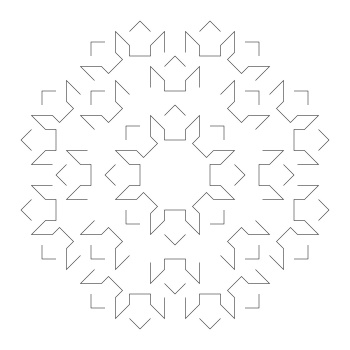











 RSS Feeds:
RSS Feeds: 

